Comprehensive Financial Analysis of Qantas and American Airlines Group
VerifiedAdded on 2021/04/24
|22
|3261
|95
Report
AI Summary
This report provides a comprehensive financial analysis of Qantas Airlines and American Airlines Group. It begins with an overview of both organizations, their future prospects, and their standing within the airline industry. The report then delves into the recent stock performance of each company and identifies key competitors. A significant portion of the report is dedicated to a detailed analysis of various financial ratios, including accounts payable and receivable turnover, inventory turnover, cash flow ratios, fixed asset turnover, and earnings per share. The analysis considers both GAAP and IFRS measures, offering a nuanced perspective on each company's financial health and performance. The report also includes a discussion of short-term and long-term credit decisions, investment decisions, employment decisions, and consulting decisions relevant to both airlines. The conclusion summarizes the key findings and provides an overall assessment of the financial positions of Qantas and American Airlines. References and an appendix are included to support the analysis.
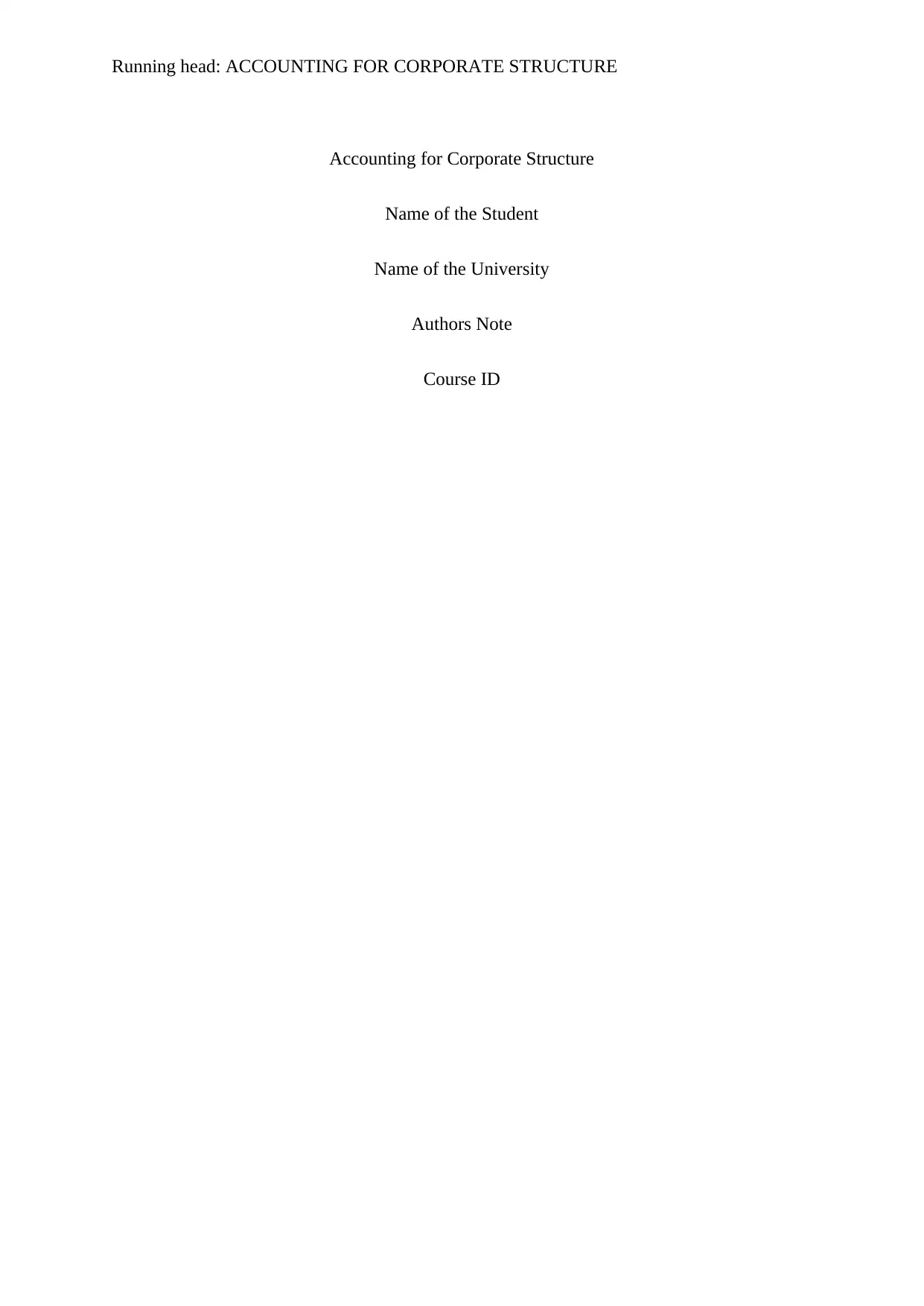
Running head: ACCOUNTING FOR CORPORATE STRUCTURE
Accounting for Corporate Structure
Name of the Student
Name of the University
Authors Note
Course ID
Accounting for Corporate Structure
Name of the Student
Name of the University
Authors Note
Course ID
Paraphrase This Document
Need a fresh take? Get an instant paraphrase of this document with our AI Paraphraser
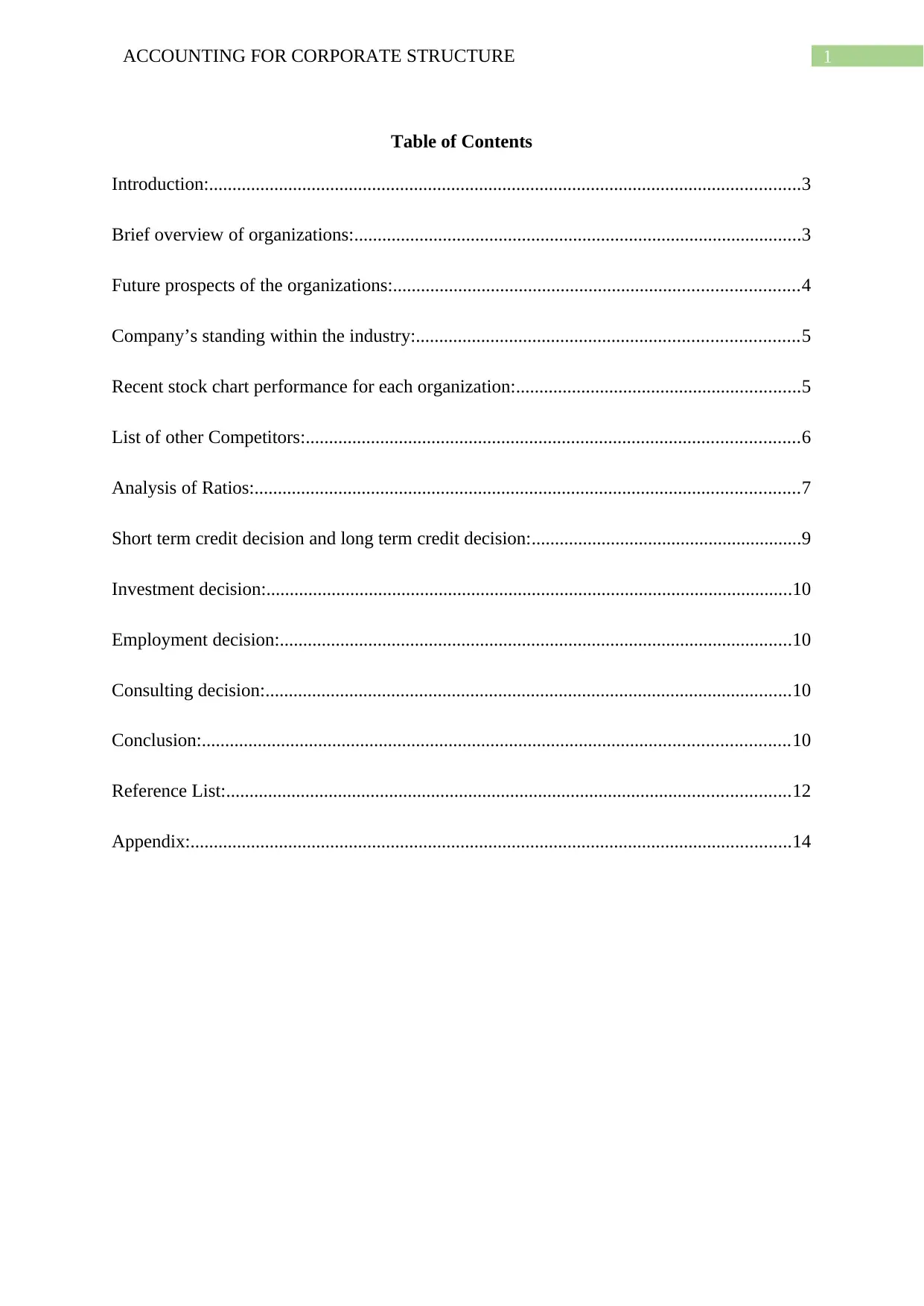
1ACCOUNTING FOR CORPORATE STRUCTURE
Table of Contents
Introduction:...............................................................................................................................3
Brief overview of organizations:................................................................................................3
Future prospects of the organizations:.......................................................................................4
Company’s standing within the industry:..................................................................................5
Recent stock chart performance for each organization:.............................................................5
List of other Competitors:..........................................................................................................6
Analysis of Ratios:.....................................................................................................................7
Short term credit decision and long term credit decision:..........................................................9
Investment decision:.................................................................................................................10
Employment decision:..............................................................................................................10
Consulting decision:.................................................................................................................10
Conclusion:..............................................................................................................................10
Reference List:.........................................................................................................................12
Appendix:.................................................................................................................................14
Table of Contents
Introduction:...............................................................................................................................3
Brief overview of organizations:................................................................................................3
Future prospects of the organizations:.......................................................................................4
Company’s standing within the industry:..................................................................................5
Recent stock chart performance for each organization:.............................................................5
List of other Competitors:..........................................................................................................6
Analysis of Ratios:.....................................................................................................................7
Short term credit decision and long term credit decision:..........................................................9
Investment decision:.................................................................................................................10
Employment decision:..............................................................................................................10
Consulting decision:.................................................................................................................10
Conclusion:..............................................................................................................................10
Reference List:.........................................................................................................................12
Appendix:.................................................................................................................................14
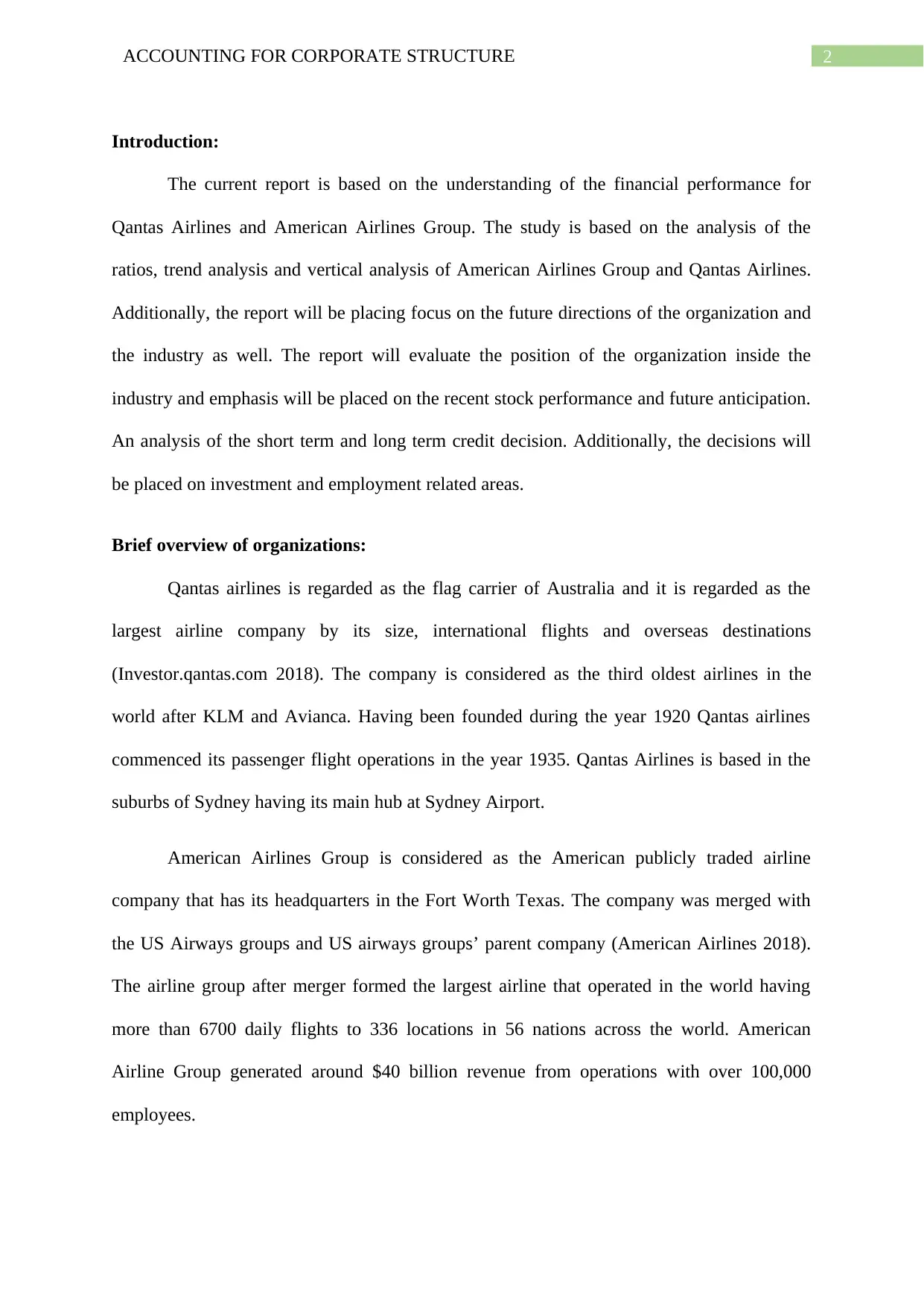
2ACCOUNTING FOR CORPORATE STRUCTURE
Introduction:
The current report is based on the understanding of the financial performance for
Qantas Airlines and American Airlines Group. The study is based on the analysis of the
ratios, trend analysis and vertical analysis of American Airlines Group and Qantas Airlines.
Additionally, the report will be placing focus on the future directions of the organization and
the industry as well. The report will evaluate the position of the organization inside the
industry and emphasis will be placed on the recent stock performance and future anticipation.
An analysis of the short term and long term credit decision. Additionally, the decisions will
be placed on investment and employment related areas.
Brief overview of organizations:
Qantas airlines is regarded as the flag carrier of Australia and it is regarded as the
largest airline company by its size, international flights and overseas destinations
(Investor.qantas.com 2018). The company is considered as the third oldest airlines in the
world after KLM and Avianca. Having been founded during the year 1920 Qantas airlines
commenced its passenger flight operations in the year 1935. Qantas Airlines is based in the
suburbs of Sydney having its main hub at Sydney Airport.
American Airlines Group is considered as the American publicly traded airline
company that has its headquarters in the Fort Worth Texas. The company was merged with
the US Airways groups and US airways groups’ parent company (American Airlines 2018).
The airline group after merger formed the largest airline that operated in the world having
more than 6700 daily flights to 336 locations in 56 nations across the world. American
Airline Group generated around $40 billion revenue from operations with over 100,000
employees.
Introduction:
The current report is based on the understanding of the financial performance for
Qantas Airlines and American Airlines Group. The study is based on the analysis of the
ratios, trend analysis and vertical analysis of American Airlines Group and Qantas Airlines.
Additionally, the report will be placing focus on the future directions of the organization and
the industry as well. The report will evaluate the position of the organization inside the
industry and emphasis will be placed on the recent stock performance and future anticipation.
An analysis of the short term and long term credit decision. Additionally, the decisions will
be placed on investment and employment related areas.
Brief overview of organizations:
Qantas airlines is regarded as the flag carrier of Australia and it is regarded as the
largest airline company by its size, international flights and overseas destinations
(Investor.qantas.com 2018). The company is considered as the third oldest airlines in the
world after KLM and Avianca. Having been founded during the year 1920 Qantas airlines
commenced its passenger flight operations in the year 1935. Qantas Airlines is based in the
suburbs of Sydney having its main hub at Sydney Airport.
American Airlines Group is considered as the American publicly traded airline
company that has its headquarters in the Fort Worth Texas. The company was merged with
the US Airways groups and US airways groups’ parent company (American Airlines 2018).
The airline group after merger formed the largest airline that operated in the world having
more than 6700 daily flights to 336 locations in 56 nations across the world. American
Airline Group generated around $40 billion revenue from operations with over 100,000
employees.
⊘ This is a preview!⊘
Do you want full access?
Subscribe today to unlock all pages.

Trusted by 1+ million students worldwide
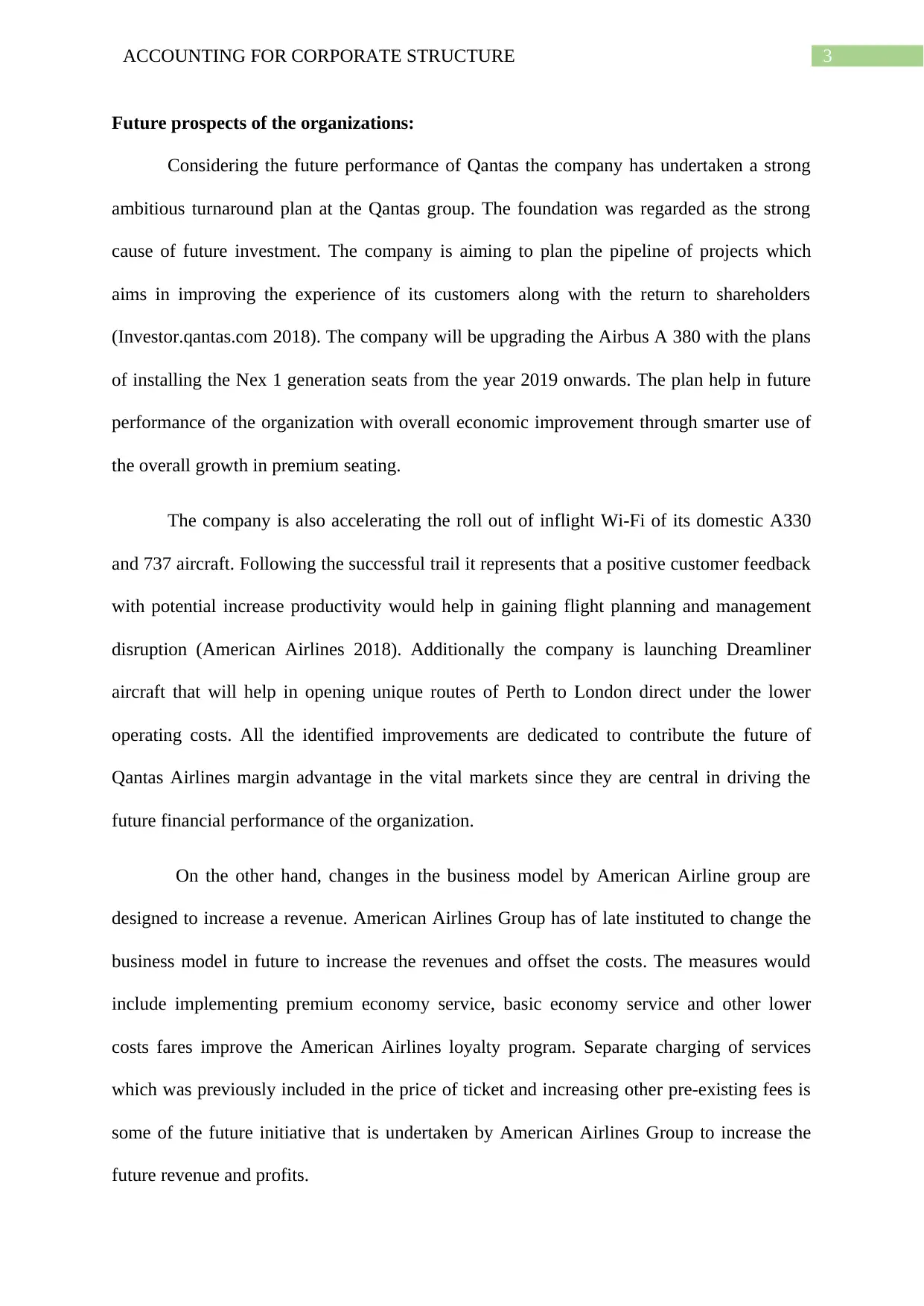
3ACCOUNTING FOR CORPORATE STRUCTURE
Future prospects of the organizations:
Considering the future performance of Qantas the company has undertaken a strong
ambitious turnaround plan at the Qantas group. The foundation was regarded as the strong
cause of future investment. The company is aiming to plan the pipeline of projects which
aims in improving the experience of its customers along with the return to shareholders
(Investor.qantas.com 2018). The company will be upgrading the Airbus A 380 with the plans
of installing the Nex 1 generation seats from the year 2019 onwards. The plan help in future
performance of the organization with overall economic improvement through smarter use of
the overall growth in premium seating.
The company is also accelerating the roll out of inflight Wi-Fi of its domestic A330
and 737 aircraft. Following the successful trail it represents that a positive customer feedback
with potential increase productivity would help in gaining flight planning and management
disruption (American Airlines 2018). Additionally the company is launching Dreamliner
aircraft that will help in opening unique routes of Perth to London direct under the lower
operating costs. All the identified improvements are dedicated to contribute the future of
Qantas Airlines margin advantage in the vital markets since they are central in driving the
future financial performance of the organization.
On the other hand, changes in the business model by American Airline group are
designed to increase a revenue. American Airlines Group has of late instituted to change the
business model in future to increase the revenues and offset the costs. The measures would
include implementing premium economy service, basic economy service and other lower
costs fares improve the American Airlines loyalty program. Separate charging of services
which was previously included in the price of ticket and increasing other pre-existing fees is
some of the future initiative that is undertaken by American Airlines Group to increase the
future revenue and profits.
Future prospects of the organizations:
Considering the future performance of Qantas the company has undertaken a strong
ambitious turnaround plan at the Qantas group. The foundation was regarded as the strong
cause of future investment. The company is aiming to plan the pipeline of projects which
aims in improving the experience of its customers along with the return to shareholders
(Investor.qantas.com 2018). The company will be upgrading the Airbus A 380 with the plans
of installing the Nex 1 generation seats from the year 2019 onwards. The plan help in future
performance of the organization with overall economic improvement through smarter use of
the overall growth in premium seating.
The company is also accelerating the roll out of inflight Wi-Fi of its domestic A330
and 737 aircraft. Following the successful trail it represents that a positive customer feedback
with potential increase productivity would help in gaining flight planning and management
disruption (American Airlines 2018). Additionally the company is launching Dreamliner
aircraft that will help in opening unique routes of Perth to London direct under the lower
operating costs. All the identified improvements are dedicated to contribute the future of
Qantas Airlines margin advantage in the vital markets since they are central in driving the
future financial performance of the organization.
On the other hand, changes in the business model by American Airline group are
designed to increase a revenue. American Airlines Group has of late instituted to change the
business model in future to increase the revenues and offset the costs. The measures would
include implementing premium economy service, basic economy service and other lower
costs fares improve the American Airlines loyalty program. Separate charging of services
which was previously included in the price of ticket and increasing other pre-existing fees is
some of the future initiative that is undertaken by American Airlines Group to increase the
future revenue and profits.
Paraphrase This Document
Need a fresh take? Get an instant paraphrase of this document with our AI Paraphraser
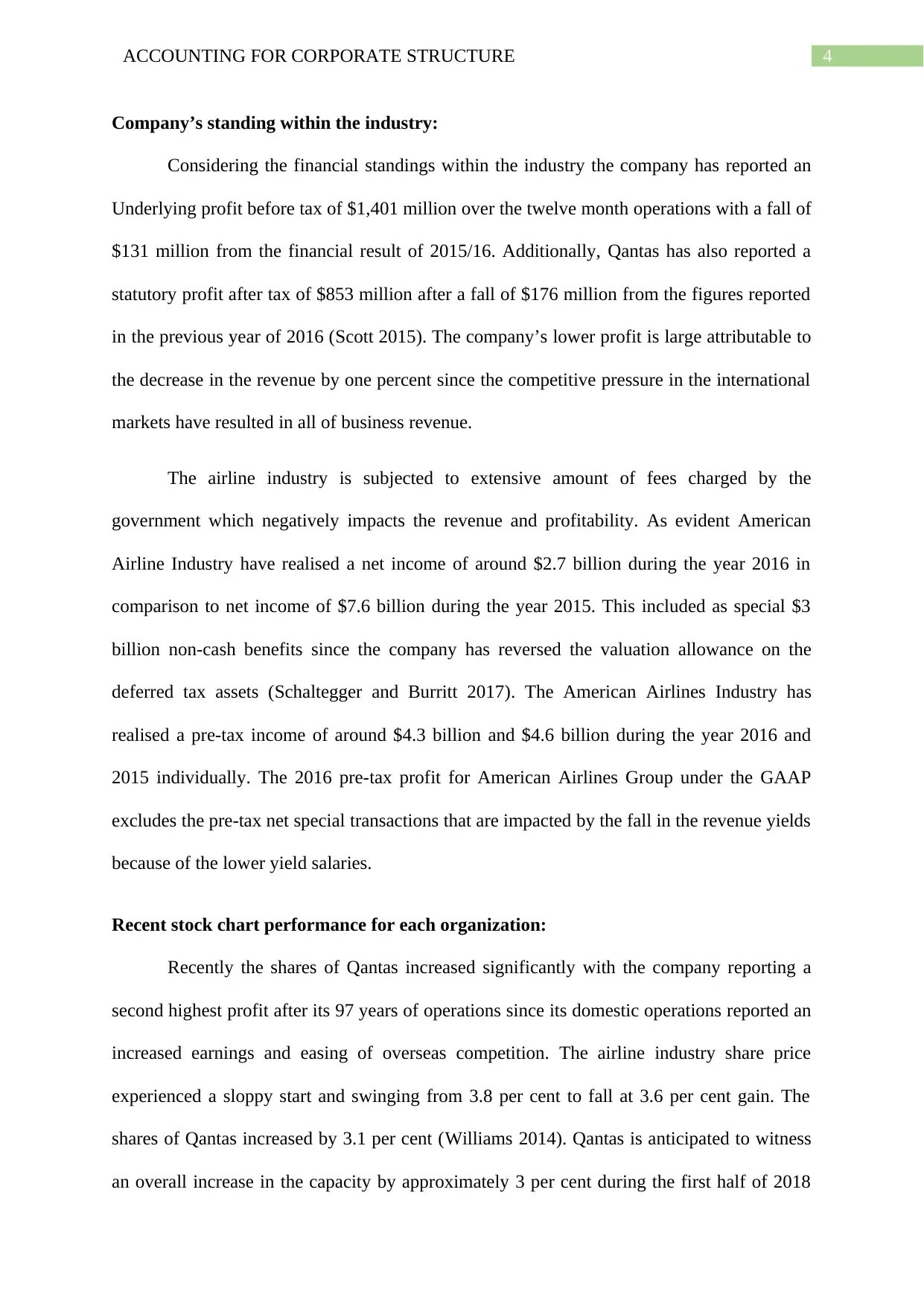
4ACCOUNTING FOR CORPORATE STRUCTURE
Company’s standing within the industry:
Considering the financial standings within the industry the company has reported an
Underlying profit before tax of $1,401 million over the twelve month operations with a fall of
$131 million from the financial result of 2015/16. Additionally, Qantas has also reported a
statutory profit after tax of $853 million after a fall of $176 million from the figures reported
in the previous year of 2016 (Scott 2015). The company’s lower profit is large attributable to
the decrease in the revenue by one percent since the competitive pressure in the international
markets have resulted in all of business revenue.
The airline industry is subjected to extensive amount of fees charged by the
government which negatively impacts the revenue and profitability. As evident American
Airline Industry have realised a net income of around $2.7 billion during the year 2016 in
comparison to net income of $7.6 billion during the year 2015. This included as special $3
billion non-cash benefits since the company has reversed the valuation allowance on the
deferred tax assets (Schaltegger and Burritt 2017). The American Airlines Industry has
realised a pre-tax income of around $4.3 billion and $4.6 billion during the year 2016 and
2015 individually. The 2016 pre-tax profit for American Airlines Group under the GAAP
excludes the pre-tax net special transactions that are impacted by the fall in the revenue yields
because of the lower yield salaries.
Recent stock chart performance for each organization:
Recently the shares of Qantas increased significantly with the company reporting a
second highest profit after its 97 years of operations since its domestic operations reported an
increased earnings and easing of overseas competition. The airline industry share price
experienced a sloppy start and swinging from 3.8 per cent to fall at 3.6 per cent gain. The
shares of Qantas increased by 3.1 per cent (Williams 2014). Qantas is anticipated to witness
an overall increase in the capacity by approximately 3 per cent during the first half of 2018
Company’s standing within the industry:
Considering the financial standings within the industry the company has reported an
Underlying profit before tax of $1,401 million over the twelve month operations with a fall of
$131 million from the financial result of 2015/16. Additionally, Qantas has also reported a
statutory profit after tax of $853 million after a fall of $176 million from the figures reported
in the previous year of 2016 (Scott 2015). The company’s lower profit is large attributable to
the decrease in the revenue by one percent since the competitive pressure in the international
markets have resulted in all of business revenue.
The airline industry is subjected to extensive amount of fees charged by the
government which negatively impacts the revenue and profitability. As evident American
Airline Industry have realised a net income of around $2.7 billion during the year 2016 in
comparison to net income of $7.6 billion during the year 2015. This included as special $3
billion non-cash benefits since the company has reversed the valuation allowance on the
deferred tax assets (Schaltegger and Burritt 2017). The American Airlines Industry has
realised a pre-tax income of around $4.3 billion and $4.6 billion during the year 2016 and
2015 individually. The 2016 pre-tax profit for American Airlines Group under the GAAP
excludes the pre-tax net special transactions that are impacted by the fall in the revenue yields
because of the lower yield salaries.
Recent stock chart performance for each organization:
Recently the shares of Qantas increased significantly with the company reporting a
second highest profit after its 97 years of operations since its domestic operations reported an
increased earnings and easing of overseas competition. The airline industry share price
experienced a sloppy start and swinging from 3.8 per cent to fall at 3.6 per cent gain. The
shares of Qantas increased by 3.1 per cent (Williams 2014). Qantas is anticipated to witness
an overall increase in the capacity by approximately 3 per cent during the first half of 2018
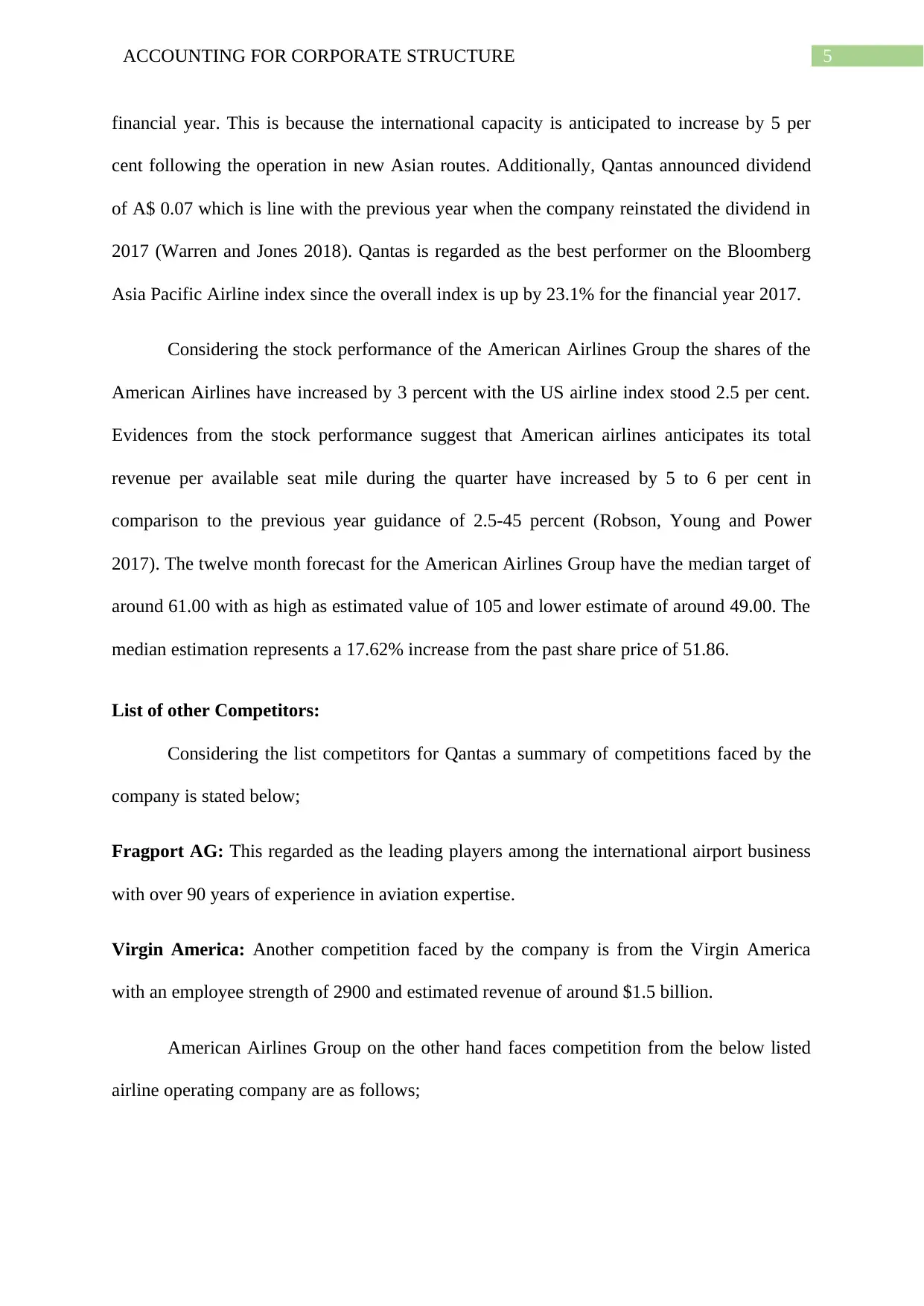
5ACCOUNTING FOR CORPORATE STRUCTURE
financial year. This is because the international capacity is anticipated to increase by 5 per
cent following the operation in new Asian routes. Additionally, Qantas announced dividend
of A$ 0.07 which is line with the previous year when the company reinstated the dividend in
2017 (Warren and Jones 2018). Qantas is regarded as the best performer on the Bloomberg
Asia Pacific Airline index since the overall index is up by 23.1% for the financial year 2017.
Considering the stock performance of the American Airlines Group the shares of the
American Airlines have increased by 3 percent with the US airline index stood 2.5 per cent.
Evidences from the stock performance suggest that American airlines anticipates its total
revenue per available seat mile during the quarter have increased by 5 to 6 per cent in
comparison to the previous year guidance of 2.5-45 percent (Robson, Young and Power
2017). The twelve month forecast for the American Airlines Group have the median target of
around 61.00 with as high as estimated value of 105 and lower estimate of around 49.00. The
median estimation represents a 17.62% increase from the past share price of 51.86.
List of other Competitors:
Considering the list competitors for Qantas a summary of competitions faced by the
company is stated below;
Fragport AG: This regarded as the leading players among the international airport business
with over 90 years of experience in aviation expertise.
Virgin America: Another competition faced by the company is from the Virgin America
with an employee strength of 2900 and estimated revenue of around $1.5 billion.
American Airlines Group on the other hand faces competition from the below listed
airline operating company are as follows;
financial year. This is because the international capacity is anticipated to increase by 5 per
cent following the operation in new Asian routes. Additionally, Qantas announced dividend
of A$ 0.07 which is line with the previous year when the company reinstated the dividend in
2017 (Warren and Jones 2018). Qantas is regarded as the best performer on the Bloomberg
Asia Pacific Airline index since the overall index is up by 23.1% for the financial year 2017.
Considering the stock performance of the American Airlines Group the shares of the
American Airlines have increased by 3 percent with the US airline index stood 2.5 per cent.
Evidences from the stock performance suggest that American airlines anticipates its total
revenue per available seat mile during the quarter have increased by 5 to 6 per cent in
comparison to the previous year guidance of 2.5-45 percent (Robson, Young and Power
2017). The twelve month forecast for the American Airlines Group have the median target of
around 61.00 with as high as estimated value of 105 and lower estimate of around 49.00. The
median estimation represents a 17.62% increase from the past share price of 51.86.
List of other Competitors:
Considering the list competitors for Qantas a summary of competitions faced by the
company is stated below;
Fragport AG: This regarded as the leading players among the international airport business
with over 90 years of experience in aviation expertise.
Virgin America: Another competition faced by the company is from the Virgin America
with an employee strength of 2900 and estimated revenue of around $1.5 billion.
American Airlines Group on the other hand faces competition from the below listed
airline operating company are as follows;
⊘ This is a preview!⊘
Do you want full access?
Subscribe today to unlock all pages.

Trusted by 1+ million students worldwide
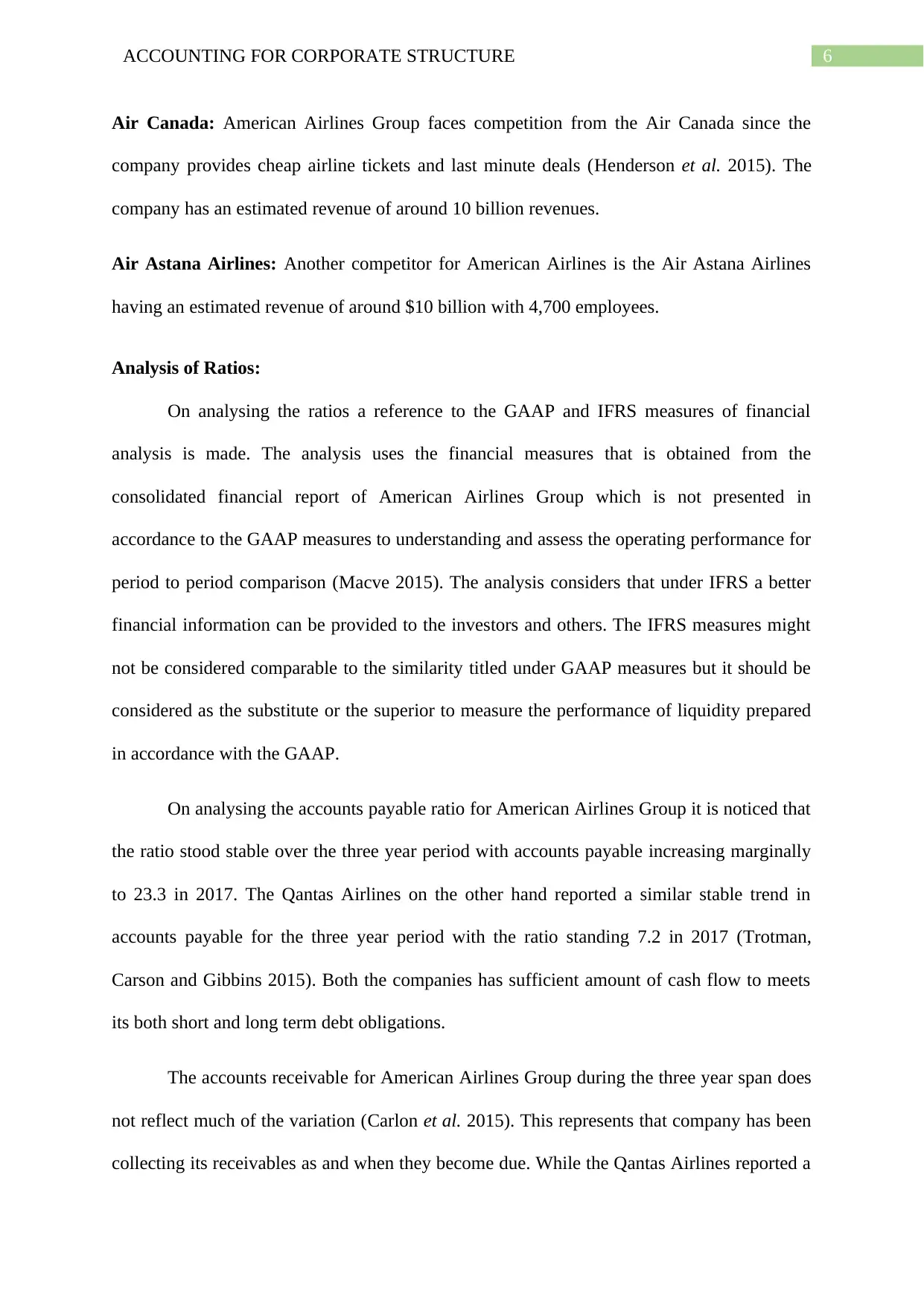
6ACCOUNTING FOR CORPORATE STRUCTURE
Air Canada: American Airlines Group faces competition from the Air Canada since the
company provides cheap airline tickets and last minute deals (Henderson et al. 2015). The
company has an estimated revenue of around 10 billion revenues.
Air Astana Airlines: Another competitor for American Airlines is the Air Astana Airlines
having an estimated revenue of around $10 billion with 4,700 employees.
Analysis of Ratios:
On analysing the ratios a reference to the GAAP and IFRS measures of financial
analysis is made. The analysis uses the financial measures that is obtained from the
consolidated financial report of American Airlines Group which is not presented in
accordance to the GAAP measures to understanding and assess the operating performance for
period to period comparison (Macve 2015). The analysis considers that under IFRS a better
financial information can be provided to the investors and others. The IFRS measures might
not be considered comparable to the similarity titled under GAAP measures but it should be
considered as the substitute or the superior to measure the performance of liquidity prepared
in accordance with the GAAP.
On analysing the accounts payable ratio for American Airlines Group it is noticed that
the ratio stood stable over the three year period with accounts payable increasing marginally
to 23.3 in 2017. The Qantas Airlines on the other hand reported a similar stable trend in
accounts payable for the three year period with the ratio standing 7.2 in 2017 (Trotman,
Carson and Gibbins 2015). Both the companies has sufficient amount of cash flow to meets
its both short and long term debt obligations.
The accounts receivable for American Airlines Group during the three year span does
not reflect much of the variation (Carlon et al. 2015). This represents that company has been
collecting its receivables as and when they become due. While the Qantas Airlines reported a
Air Canada: American Airlines Group faces competition from the Air Canada since the
company provides cheap airline tickets and last minute deals (Henderson et al. 2015). The
company has an estimated revenue of around 10 billion revenues.
Air Astana Airlines: Another competitor for American Airlines is the Air Astana Airlines
having an estimated revenue of around $10 billion with 4,700 employees.
Analysis of Ratios:
On analysing the ratios a reference to the GAAP and IFRS measures of financial
analysis is made. The analysis uses the financial measures that is obtained from the
consolidated financial report of American Airlines Group which is not presented in
accordance to the GAAP measures to understanding and assess the operating performance for
period to period comparison (Macve 2015). The analysis considers that under IFRS a better
financial information can be provided to the investors and others. The IFRS measures might
not be considered comparable to the similarity titled under GAAP measures but it should be
considered as the substitute or the superior to measure the performance of liquidity prepared
in accordance with the GAAP.
On analysing the accounts payable ratio for American Airlines Group it is noticed that
the ratio stood stable over the three year period with accounts payable increasing marginally
to 23.3 in 2017. The Qantas Airlines on the other hand reported a similar stable trend in
accounts payable for the three year period with the ratio standing 7.2 in 2017 (Trotman,
Carson and Gibbins 2015). Both the companies has sufficient amount of cash flow to meets
its both short and long term debt obligations.
The accounts receivable for American Airlines Group during the three year span does
not reflect much of the variation (Carlon et al. 2015). This represents that company has been
collecting its receivables as and when they become due. While the Qantas Airlines reported a
Paraphrase This Document
Need a fresh take? Get an instant paraphrase of this document with our AI Paraphraser
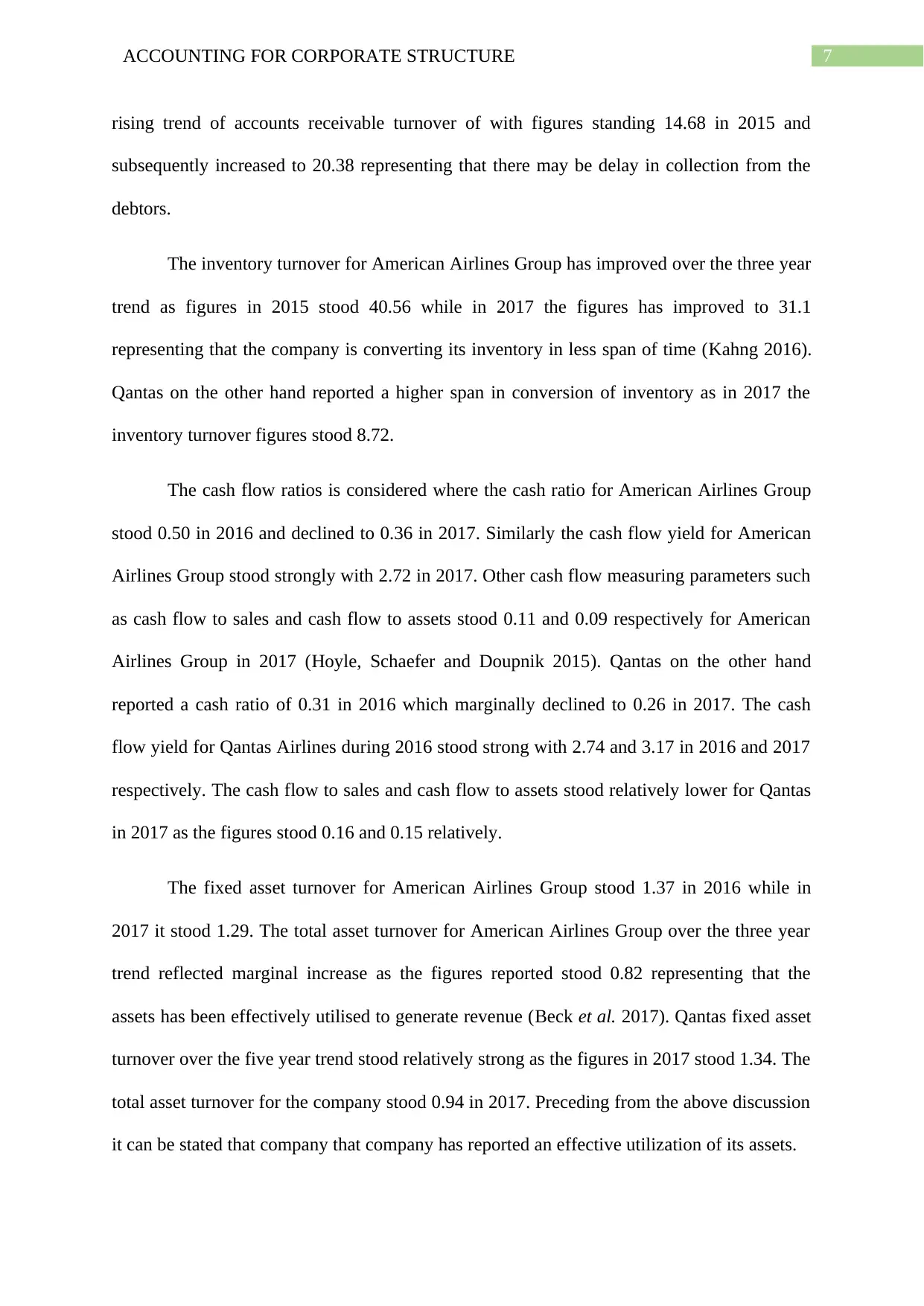
7ACCOUNTING FOR CORPORATE STRUCTURE
rising trend of accounts receivable turnover of with figures standing 14.68 in 2015 and
subsequently increased to 20.38 representing that there may be delay in collection from the
debtors.
The inventory turnover for American Airlines Group has improved over the three year
trend as figures in 2015 stood 40.56 while in 2017 the figures has improved to 31.1
representing that the company is converting its inventory in less span of time (Kahng 2016).
Qantas on the other hand reported a higher span in conversion of inventory as in 2017 the
inventory turnover figures stood 8.72.
The cash flow ratios is considered where the cash ratio for American Airlines Group
stood 0.50 in 2016 and declined to 0.36 in 2017. Similarly the cash flow yield for American
Airlines Group stood strongly with 2.72 in 2017. Other cash flow measuring parameters such
as cash flow to sales and cash flow to assets stood 0.11 and 0.09 respectively for American
Airlines Group in 2017 (Hoyle, Schaefer and Doupnik 2015). Qantas on the other hand
reported a cash ratio of 0.31 in 2016 which marginally declined to 0.26 in 2017. The cash
flow yield for Qantas Airlines during 2016 stood strong with 2.74 and 3.17 in 2016 and 2017
respectively. The cash flow to sales and cash flow to assets stood relatively lower for Qantas
in 2017 as the figures stood 0.16 and 0.15 relatively.
The fixed asset turnover for American Airlines Group stood 1.37 in 2016 while in
2017 it stood 1.29. The total asset turnover for American Airlines Group over the three year
trend reflected marginal increase as the figures reported stood 0.82 representing that the
assets has been effectively utilised to generate revenue (Beck et al. 2017). Qantas fixed asset
turnover over the five year trend stood relatively strong as the figures in 2017 stood 1.34. The
total asset turnover for the company stood 0.94 in 2017. Preceding from the above discussion
it can be stated that company that company has reported an effective utilization of its assets.
rising trend of accounts receivable turnover of with figures standing 14.68 in 2015 and
subsequently increased to 20.38 representing that there may be delay in collection from the
debtors.
The inventory turnover for American Airlines Group has improved over the three year
trend as figures in 2015 stood 40.56 while in 2017 the figures has improved to 31.1
representing that the company is converting its inventory in less span of time (Kahng 2016).
Qantas on the other hand reported a higher span in conversion of inventory as in 2017 the
inventory turnover figures stood 8.72.
The cash flow ratios is considered where the cash ratio for American Airlines Group
stood 0.50 in 2016 and declined to 0.36 in 2017. Similarly the cash flow yield for American
Airlines Group stood strongly with 2.72 in 2017. Other cash flow measuring parameters such
as cash flow to sales and cash flow to assets stood 0.11 and 0.09 respectively for American
Airlines Group in 2017 (Hoyle, Schaefer and Doupnik 2015). Qantas on the other hand
reported a cash ratio of 0.31 in 2016 which marginally declined to 0.26 in 2017. The cash
flow yield for Qantas Airlines during 2016 stood strong with 2.74 and 3.17 in 2016 and 2017
respectively. The cash flow to sales and cash flow to assets stood relatively lower for Qantas
in 2017 as the figures stood 0.16 and 0.15 relatively.
The fixed asset turnover for American Airlines Group stood 1.37 in 2016 while in
2017 it stood 1.29. The total asset turnover for American Airlines Group over the three year
trend reflected marginal increase as the figures reported stood 0.82 representing that the
assets has been effectively utilised to generate revenue (Beck et al. 2017). Qantas fixed asset
turnover over the five year trend stood relatively strong as the figures in 2017 stood 1.34. The
total asset turnover for the company stood 0.94 in 2017. Preceding from the above discussion
it can be stated that company that company has reported an effective utilization of its assets.
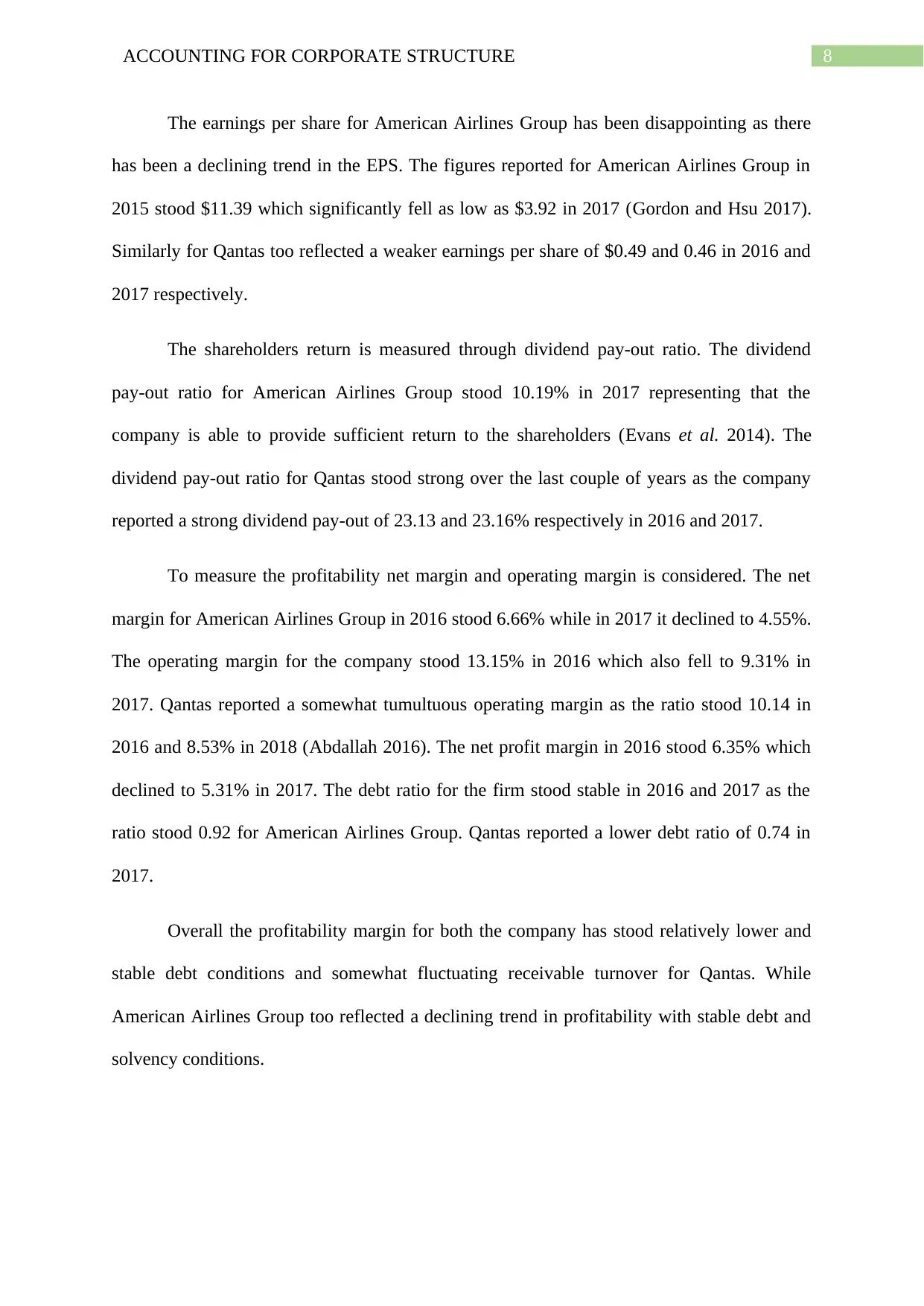
8ACCOUNTING FOR CORPORATE STRUCTURE
The earnings per share for American Airlines Group has been disappointing as there
has been a declining trend in the EPS. The figures reported for American Airlines Group in
2015 stood $11.39 which significantly fell as low as $3.92 in 2017 (Gordon and Hsu 2017).
Similarly for Qantas too reflected a weaker earnings per share of $0.49 and 0.46 in 2016 and
2017 respectively.
The shareholders return is measured through dividend pay-out ratio. The dividend
pay-out ratio for American Airlines Group stood 10.19% in 2017 representing that the
company is able to provide sufficient return to the shareholders (Evans et al. 2014). The
dividend pay-out ratio for Qantas stood strong over the last couple of years as the company
reported a strong dividend pay-out of 23.13 and 23.16% respectively in 2016 and 2017.
To measure the profitability net margin and operating margin is considered. The net
margin for American Airlines Group in 2016 stood 6.66% while in 2017 it declined to 4.55%.
The operating margin for the company stood 13.15% in 2016 which also fell to 9.31% in
2017. Qantas reported a somewhat tumultuous operating margin as the ratio stood 10.14 in
2016 and 8.53% in 2018 (Abdallah 2016). The net profit margin in 2016 stood 6.35% which
declined to 5.31% in 2017. The debt ratio for the firm stood stable in 2016 and 2017 as the
ratio stood 0.92 for American Airlines Group. Qantas reported a lower debt ratio of 0.74 in
2017.
Overall the profitability margin for both the company has stood relatively lower and
stable debt conditions and somewhat fluctuating receivable turnover for Qantas. While
American Airlines Group too reflected a declining trend in profitability with stable debt and
solvency conditions.
The earnings per share for American Airlines Group has been disappointing as there
has been a declining trend in the EPS. The figures reported for American Airlines Group in
2015 stood $11.39 which significantly fell as low as $3.92 in 2017 (Gordon and Hsu 2017).
Similarly for Qantas too reflected a weaker earnings per share of $0.49 and 0.46 in 2016 and
2017 respectively.
The shareholders return is measured through dividend pay-out ratio. The dividend
pay-out ratio for American Airlines Group stood 10.19% in 2017 representing that the
company is able to provide sufficient return to the shareholders (Evans et al. 2014). The
dividend pay-out ratio for Qantas stood strong over the last couple of years as the company
reported a strong dividend pay-out of 23.13 and 23.16% respectively in 2016 and 2017.
To measure the profitability net margin and operating margin is considered. The net
margin for American Airlines Group in 2016 stood 6.66% while in 2017 it declined to 4.55%.
The operating margin for the company stood 13.15% in 2016 which also fell to 9.31% in
2017. Qantas reported a somewhat tumultuous operating margin as the ratio stood 10.14 in
2016 and 8.53% in 2018 (Abdallah 2016). The net profit margin in 2016 stood 6.35% which
declined to 5.31% in 2017. The debt ratio for the firm stood stable in 2016 and 2017 as the
ratio stood 0.92 for American Airlines Group. Qantas reported a lower debt ratio of 0.74 in
2017.
Overall the profitability margin for both the company has stood relatively lower and
stable debt conditions and somewhat fluctuating receivable turnover for Qantas. While
American Airlines Group too reflected a declining trend in profitability with stable debt and
solvency conditions.
⊘ This is a preview!⊘
Do you want full access?
Subscribe today to unlock all pages.

Trusted by 1+ million students worldwide
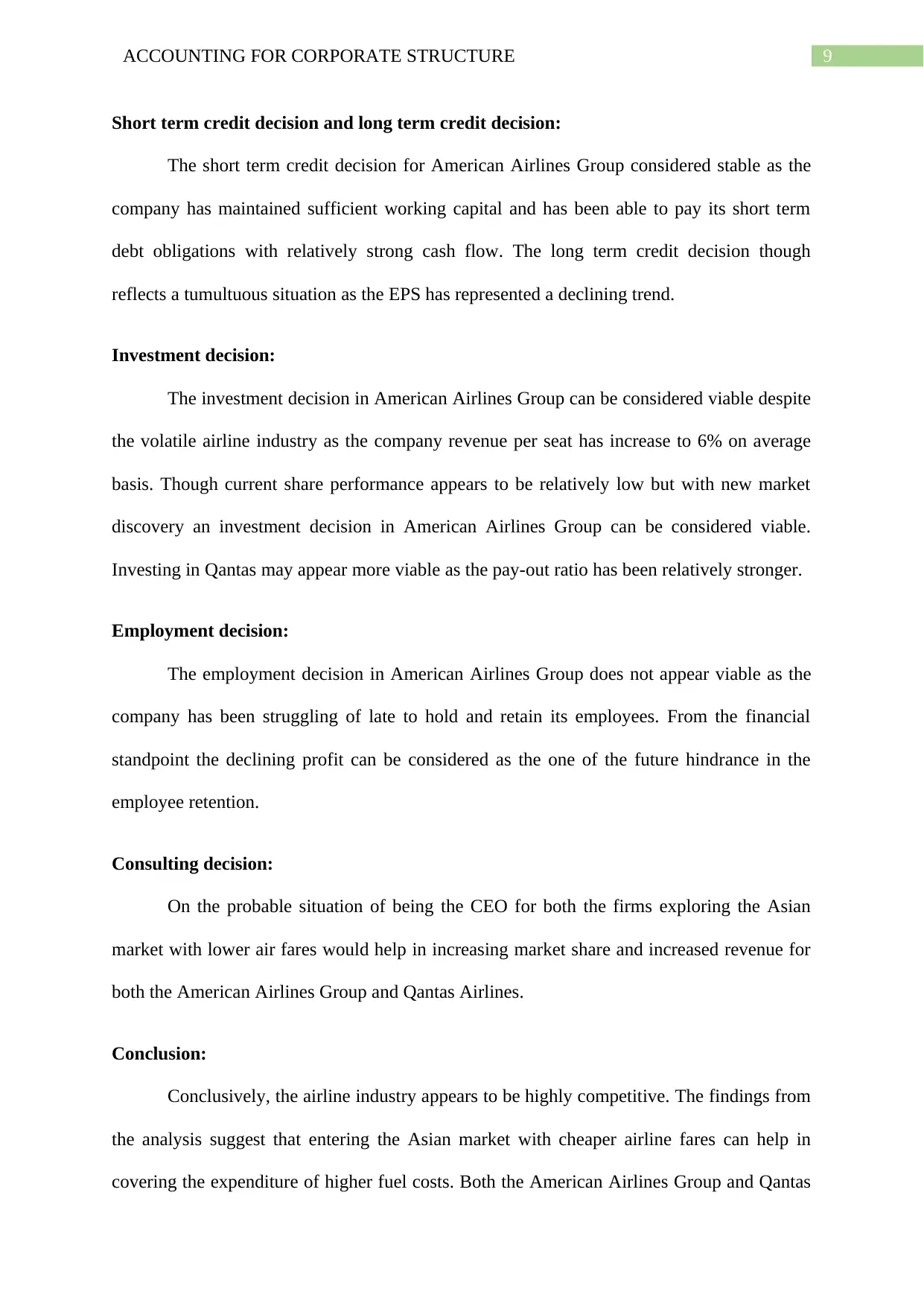
9ACCOUNTING FOR CORPORATE STRUCTURE
Short term credit decision and long term credit decision:
The short term credit decision for American Airlines Group considered stable as the
company has maintained sufficient working capital and has been able to pay its short term
debt obligations with relatively strong cash flow. The long term credit decision though
reflects a tumultuous situation as the EPS has represented a declining trend.
Investment decision:
The investment decision in American Airlines Group can be considered viable despite
the volatile airline industry as the company revenue per seat has increase to 6% on average
basis. Though current share performance appears to be relatively low but with new market
discovery an investment decision in American Airlines Group can be considered viable.
Investing in Qantas may appear more viable as the pay-out ratio has been relatively stronger.
Employment decision:
The employment decision in American Airlines Group does not appear viable as the
company has been struggling of late to hold and retain its employees. From the financial
standpoint the declining profit can be considered as the one of the future hindrance in the
employee retention.
Consulting decision:
On the probable situation of being the CEO for both the firms exploring the Asian
market with lower air fares would help in increasing market share and increased revenue for
both the American Airlines Group and Qantas Airlines.
Conclusion:
Conclusively, the airline industry appears to be highly competitive. The findings from
the analysis suggest that entering the Asian market with cheaper airline fares can help in
covering the expenditure of higher fuel costs. Both the American Airlines Group and Qantas
Short term credit decision and long term credit decision:
The short term credit decision for American Airlines Group considered stable as the
company has maintained sufficient working capital and has been able to pay its short term
debt obligations with relatively strong cash flow. The long term credit decision though
reflects a tumultuous situation as the EPS has represented a declining trend.
Investment decision:
The investment decision in American Airlines Group can be considered viable despite
the volatile airline industry as the company revenue per seat has increase to 6% on average
basis. Though current share performance appears to be relatively low but with new market
discovery an investment decision in American Airlines Group can be considered viable.
Investing in Qantas may appear more viable as the pay-out ratio has been relatively stronger.
Employment decision:
The employment decision in American Airlines Group does not appear viable as the
company has been struggling of late to hold and retain its employees. From the financial
standpoint the declining profit can be considered as the one of the future hindrance in the
employee retention.
Consulting decision:
On the probable situation of being the CEO for both the firms exploring the Asian
market with lower air fares would help in increasing market share and increased revenue for
both the American Airlines Group and Qantas Airlines.
Conclusion:
Conclusively, the airline industry appears to be highly competitive. The findings from
the analysis suggest that entering the Asian market with cheaper airline fares can help in
covering the expenditure of higher fuel costs. Both the American Airlines Group and Qantas
Paraphrase This Document
Need a fresh take? Get an instant paraphrase of this document with our AI Paraphraser
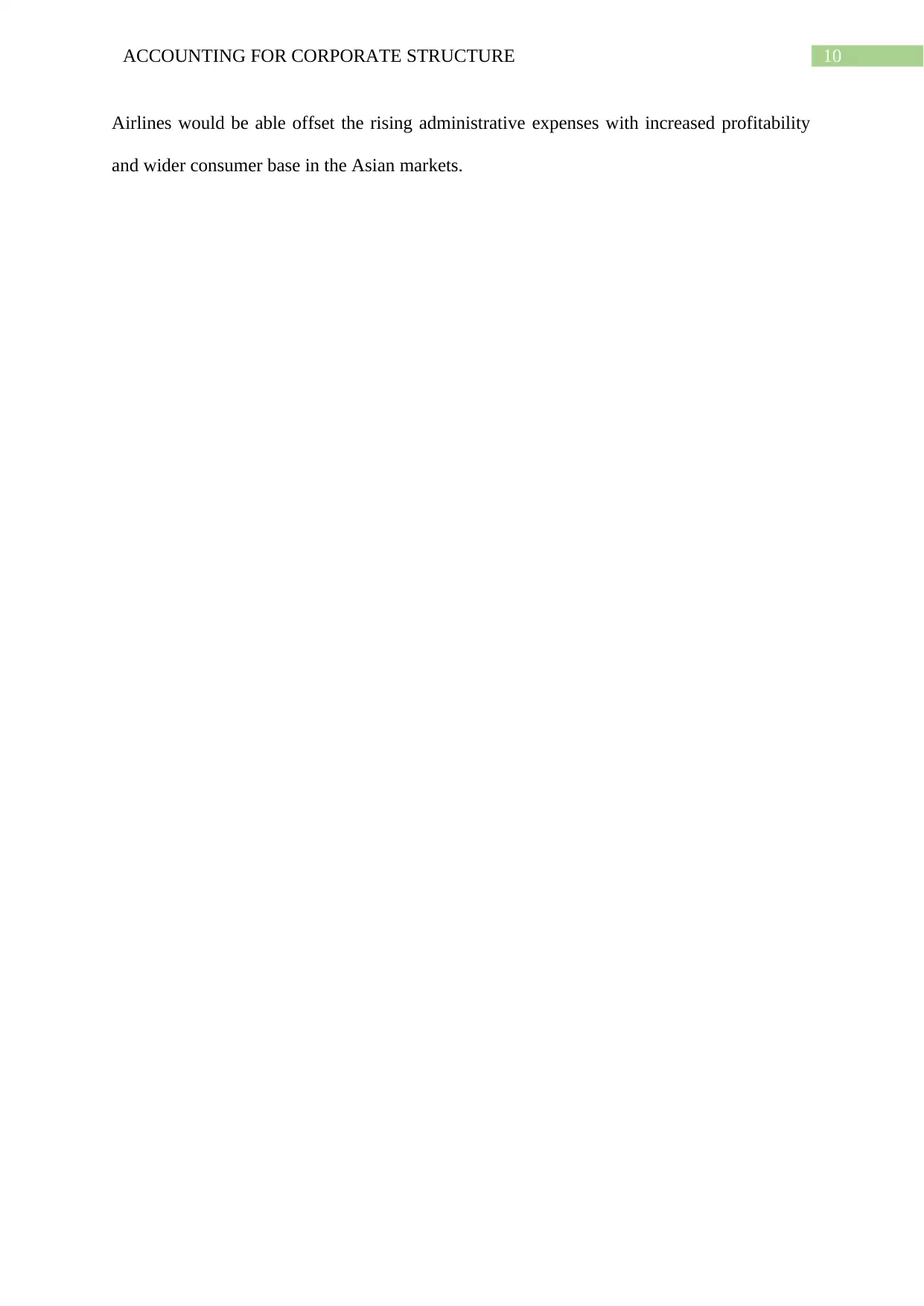
10ACCOUNTING FOR CORPORATE STRUCTURE
Airlines would be able offset the rising administrative expenses with increased profitability
and wider consumer base in the Asian markets.
Airlines would be able offset the rising administrative expenses with increased profitability
and wider consumer base in the Asian markets.
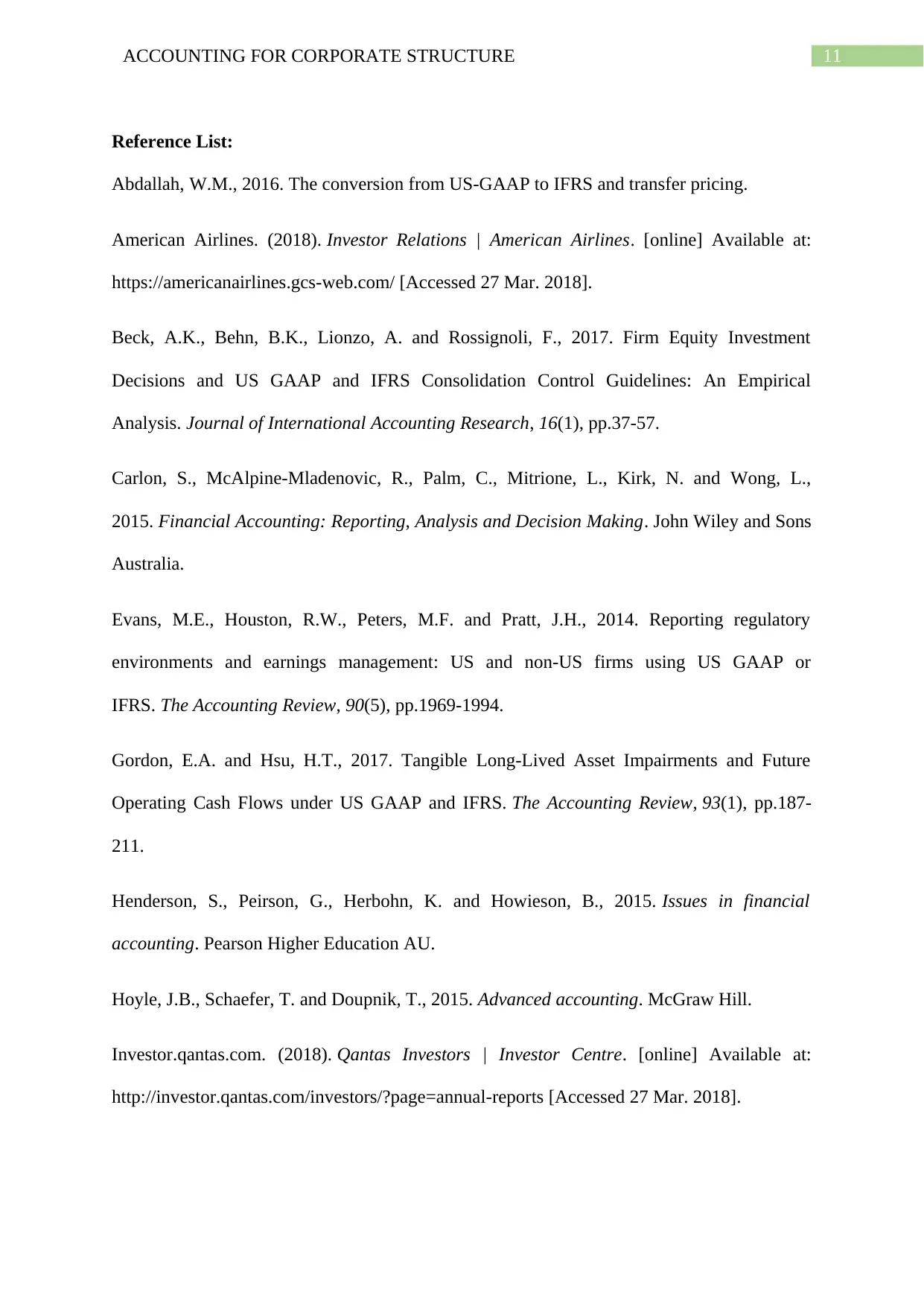
11ACCOUNTING FOR CORPORATE STRUCTURE
Reference List:
Abdallah, W.M., 2016. The conversion from US-GAAP to IFRS and transfer pricing.
American Airlines. (2018). Investor Relations | American Airlines. [online] Available at:
https://americanairlines.gcs-web.com/ [Accessed 27 Mar. 2018].
Beck, A.K., Behn, B.K., Lionzo, A. and Rossignoli, F., 2017. Firm Equity Investment
Decisions and US GAAP and IFRS Consolidation Control Guidelines: An Empirical
Analysis. Journal of International Accounting Research, 16(1), pp.37-57.
Carlon, S., McAlpine-Mladenovic, R., Palm, C., Mitrione, L., Kirk, N. and Wong, L.,
2015. Financial Accounting: Reporting, Analysis and Decision Making. John Wiley and Sons
Australia.
Evans, M.E., Houston, R.W., Peters, M.F. and Pratt, J.H., 2014. Reporting regulatory
environments and earnings management: US and non-US firms using US GAAP or
IFRS. The Accounting Review, 90(5), pp.1969-1994.
Gordon, E.A. and Hsu, H.T., 2017. Tangible Long-Lived Asset Impairments and Future
Operating Cash Flows under US GAAP and IFRS. The Accounting Review, 93(1), pp.187-
211.
Henderson, S., Peirson, G., Herbohn, K. and Howieson, B., 2015. Issues in financial
accounting. Pearson Higher Education AU.
Hoyle, J.B., Schaefer, T. and Doupnik, T., 2015. Advanced accounting. McGraw Hill.
Investor.qantas.com. (2018). Qantas Investors | Investor Centre. [online] Available at:
http://investor.qantas.com/investors/?page=annual-reports [Accessed 27 Mar. 2018].
Reference List:
Abdallah, W.M., 2016. The conversion from US-GAAP to IFRS and transfer pricing.
American Airlines. (2018). Investor Relations | American Airlines. [online] Available at:
https://americanairlines.gcs-web.com/ [Accessed 27 Mar. 2018].
Beck, A.K., Behn, B.K., Lionzo, A. and Rossignoli, F., 2017. Firm Equity Investment
Decisions and US GAAP and IFRS Consolidation Control Guidelines: An Empirical
Analysis. Journal of International Accounting Research, 16(1), pp.37-57.
Carlon, S., McAlpine-Mladenovic, R., Palm, C., Mitrione, L., Kirk, N. and Wong, L.,
2015. Financial Accounting: Reporting, Analysis and Decision Making. John Wiley and Sons
Australia.
Evans, M.E., Houston, R.W., Peters, M.F. and Pratt, J.H., 2014. Reporting regulatory
environments and earnings management: US and non-US firms using US GAAP or
IFRS. The Accounting Review, 90(5), pp.1969-1994.
Gordon, E.A. and Hsu, H.T., 2017. Tangible Long-Lived Asset Impairments and Future
Operating Cash Flows under US GAAP and IFRS. The Accounting Review, 93(1), pp.187-
211.
Henderson, S., Peirson, G., Herbohn, K. and Howieson, B., 2015. Issues in financial
accounting. Pearson Higher Education AU.
Hoyle, J.B., Schaefer, T. and Doupnik, T., 2015. Advanced accounting. McGraw Hill.
Investor.qantas.com. (2018). Qantas Investors | Investor Centre. [online] Available at:
http://investor.qantas.com/investors/?page=annual-reports [Accessed 27 Mar. 2018].
⊘ This is a preview!⊘
Do you want full access?
Subscribe today to unlock all pages.

Trusted by 1+ million students worldwide
1 out of 22
Related Documents
Your All-in-One AI-Powered Toolkit for Academic Success.
+13062052269
info@desklib.com
Available 24*7 on WhatsApp / Email
![[object Object]](/_next/static/media/star-bottom.7253800d.svg)
Unlock your academic potential
Copyright © 2020–2025 A2Z Services. All Rights Reserved. Developed and managed by ZUCOL.





